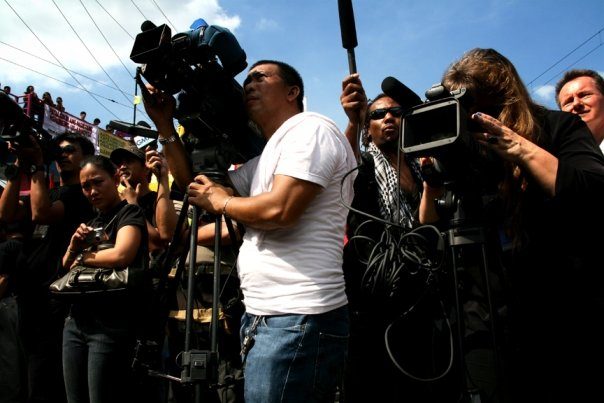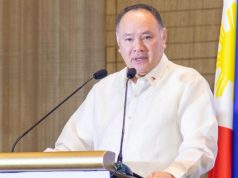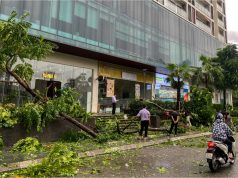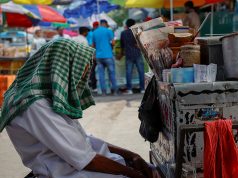MANILA, Philippines — Although constantly accused of being “biased” and even peddling “fake news,” Philippine media fared very well in a survey of 38 countries whose publics were asked how they viewed the quality and fairness of news coverage.
The Philippine results of the Pew Research Center’s 2017 Global Attitudes Survey showed that 87 percent of respondents said media did well covering important events, 86 percent said news was covered accurately, 83 percent said coverage of government leaders was done well, and the fewest, 78 percent, said political issues were covered fairly.
Publics Globally Want Unbiased News Coverage, but Are Divided on Whether Their News Media Deliver
This placed the country’s media next only to Tanzania’s, whose media scored 92 percent, 93 percent, 89 percent and 83 percent, respectively, in the same areas.
This pattern was generally consistent among all countries surveyed, with Pew noting that, “while publics around the globe place a premium on politically unbiased news media, this is precisely the performance area, among four asked about, where publics are least likely to say their news media are doing well.”
“A median of only 52 percent across the 38 nations polled say the news media in their country do a good job of reporting on political issues fairly, while 44 percent say they do not,” the non-partisan Washington DC-based think tank said.
“And although majorities of the public in 18 countries say their news media are performing well in this area, attitudes are more negative in the remaining 20 nations surveyed. The most critical are Spain, Greece, South Korea, Lebanon and Chile, where at least six-in-ten say their news media do not do well on reporting the news fairly,” it added.
Here is a summary of the survey’s key findings:
- Global publics want politically balanced news, but do not think their news media are doing very well in this area
- Publics around the world follow national and local news more closely than international
- People in poorer countries just as likely to use social media for news as those in wealthier countries
Pew also noted that “within countries, political identification tends to be the strongest divider of media attitudes, more so than education, age or gender.”
The U.S., where the divide is more defined, placed 24th in the survey, with 61 percent saying media did well covering important events, 56 percent saying news was covered accurately, 58 percent saying coverage of government leaders was done well, and 47 percent saying political issues were covered fairly.
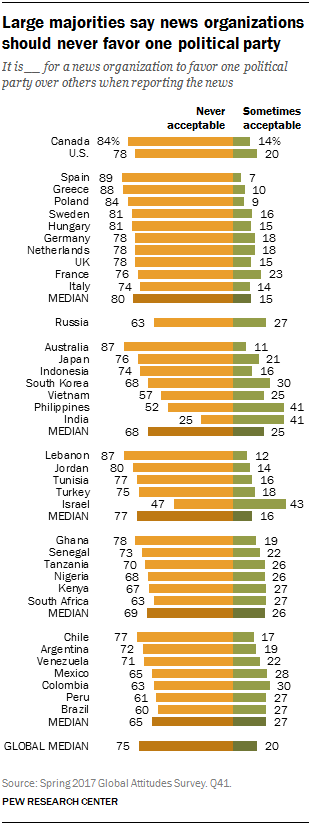
Interestingly, however, while the Philippines fared well in how the public viewed media coverage, Pew said the country and Israel “stand as relative exceptions to the strong global consensus” that news organizations should never favor a political party over others.
“In both of these countries, about four-in-ten say it is acceptable for news organizations to sometimes favor one political party over others,” Pew noted.
For the Philippines, this translated to 41 percent saying it was okay for news organizations to be at times biased for one political party, as against 52 percent who said this is never acceptable.
“Trust in government is also related to media satisfaction at the individual level. Within many countries, people who express confidence in the national government are more likely to be satisfied with the news media than those who are less confident,” Pew also noted.
In the country, though the general perception is many government supporters generally disapprove of media, Pew’s survey shows otherwise, with high satisfaction in both government and media.

The survey also found that age is a factor in the type of news people are interested in.
“In 20 countries, people ages 50 and older are significantly more likely than people younger than 30 to closely follow local news,” with the age gap “at least 15 percentage points in 11 of the countries.”
“Only in the Philippines and Brazil is the pattern reversed; there, young people are more likely to follow local news,” it said.
As for accessing news online, Pew said” “Across countries, a global median of 42% say they use the internet to get news at least once a day (either once a day or several times a day). Another 20% go online less than once a day to get news and 35% say they never do so.”
In the Philippines, 20 percent said they get their news online at least once a day.
But while looking for news on the internet was linked to economic status, accessing news through social media “is not strongly related to country-level wealth. People in advanced economies (median of 36%) use social media daily for news at similar rates to those in emerging or developing economies (33%),” Pew noted.
In the Philippines, 27 percent said they use social media to get news daily, with the youth aged 18-29 making up 49 percent of this segment.

